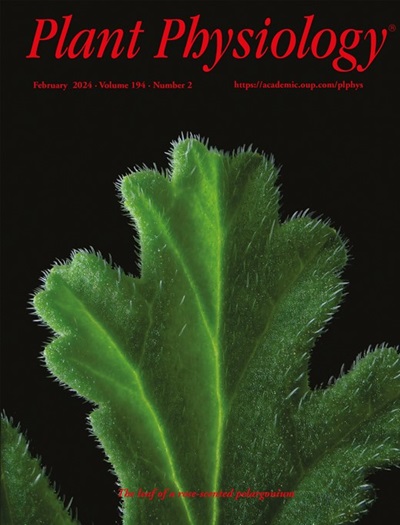Rice JASMONIC ACID OXIDASES control resting jasmonate metabolism to promote growth and repress basal immune responses
IF 6.5
1区 生物学
Q1 PLANT SCIENCES
引用次数: 0
Abstract
Catabolic conversions within the jasmonate pathway have substantial consequences on phytohormone signaling output. In dicots, the jasmonic acid oxidase (JAO) catabolic route leads to jasmonic acid (JA) hydroxylation, which limits its conjugation into bioactive jasmonoyl-isoleucine (JA-Ile). Here, we functionally characterized the JAO pathway in rice (Oryza sativa) and demonstrated its key function in promoting growth and attenuating JA responses in vegetative tissues. The rice genome encodes four JAO-related homologs, three of which generate hydroxy-JA in vitro and rescue the high-defense phenotype of the Arabidopsis jao2-2 mutant. By generating and analyzing a series of single to quadruple rice jao mutants, we showed additive effects of cumulative JAO depletion on JA metabolism, basal defense levels, growth inhibition, fitness and global metabolic reprogramming. The growth of JAO-deficient lines was substantially repressed at the juvenile stage, while the impact was milder in later vegetative development, during which plants opposed enhanced resistance to virulent and avirulent strains of Magnaporthe oryzae, the causal agent of fungal blast disease. Moreover, jao mutants exhibited slightly reduced fertility and impaired seed filling. Our findings identify the JAO pathway as an integral component of basal JA/JA-Ile homeostasis and an important determinant of the growth-defense tradeoff in rice. The regulatory function of this pathway is conserved in monocots, opening possibilities for selectively modulating basal JA responses in major cereal crops to optimize agronomic traits.水稻茉莉酸氧化酶控制静止茉莉酸代谢,促进生长和抑制基础免疫反应
茉莉酸途径内的分解代谢转化对植物激素信号输出有实质性的影响。在仙人掌中,茉莉酸氧化酶(JAO)分解代谢途径导致茉莉酸(JA)羟基化,这限制了其结合成具有生物活性的茉莉异亮氨酸(JA- ile)。在此,我们对水稻(Oryza sativa)的JAO通路进行了功能表征,并证明了其在促进生长和减弱营养组织中JA反应中的关键功能。水稻基因组编码4个与jao相关的同源物,其中3个在体外产生羟基ja,并挽救了拟南芥jao2-2突变体的高防御表型。通过产生和分析一系列单到四重水稻jao突变体,我们发现累积jao耗竭对JA代谢、基础防御水平、生长抑制、适应度和全局代谢重编程的加性效应。jao缺陷品系的生长在幼苗期受到明显抑制,而在营养发育后期受到的影响较轻,在此期间,植株对稻瘟病病原稻瘟菌(Magnaporthe oryzae)强毒株和无毒株的抗性增强。此外,jao突变体的育性略有下降,种子灌浆受损。我们的研究结果表明,JAO途径是水稻JA/JA- ile基础稳态的一个组成部分,也是水稻生长防御权衡的一个重要决定因素。该途径的调控功能在单子房中是保守的,这为选择性调节主要谷类作物的基础JA反应以优化农艺性状提供了可能性。
本文章由计算机程序翻译,如有差异,请以英文原文为准。
求助全文
约1分钟内获得全文
求助全文
来源期刊

Plant Physiology
生物-植物科学
CiteScore
12.20
自引率
5.40%
发文量
535
审稿时长
2.3 months
期刊介绍:
Plant Physiology® is a distinguished and highly respected journal with a rich history dating back to its establishment in 1926. It stands as a leading international publication in the field of plant biology, covering a comprehensive range of topics from the molecular and structural aspects of plant life to systems biology and ecophysiology. Recognized as the most highly cited journal in plant sciences, Plant Physiology® is a testament to its commitment to excellence and the dissemination of groundbreaking research.
As the official publication of the American Society of Plant Biologists, Plant Physiology® upholds rigorous peer-review standards, ensuring that the scientific community receives the highest quality research. The journal releases 12 issues annually, providing a steady stream of new findings and insights to its readership.
 求助内容:
求助内容: 应助结果提醒方式:
应助结果提醒方式:


